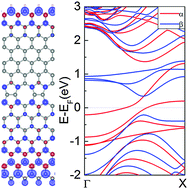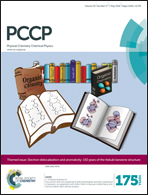First-principles study of line-defect-embedded zigzag graphene nanoribbons: electronic and magnetic properties†
Abstract
Based on first-principles calculations, we present the electronic and magnetic properties of a class of line defect-embedded zigzag graphene nanoribbons, with one edge saturated by two hydrogen atoms per carbon atom and the other edge terminated by only one hydrogen atom. Such edge-modified nanoribbons without line defects are found to be typical bipolar magnetic semiconductors (BMS). In contrast, when the line defect is introduced into the ribbons, the ground state is ferromagnetic, and the resulting nanoribbons can be tuned to spin-polarized metal, metal with Dirac point, or half-metal by varying the position of the line defect, owing to the defect-induced self-doping of the BMS. Specifically, when the line defect is far away from the edges of the ribbon, the system shows half-metallicity. We further confirm the structural and magnetic stability at room temperature by first-principles molecular dynamics simulations. Our findings reveal the possibility of building metal-free electronic/spintronic devices with magnetic/half-metallic graphene nanoribbons.


 Please wait while we load your content...
Please wait while we load your content...